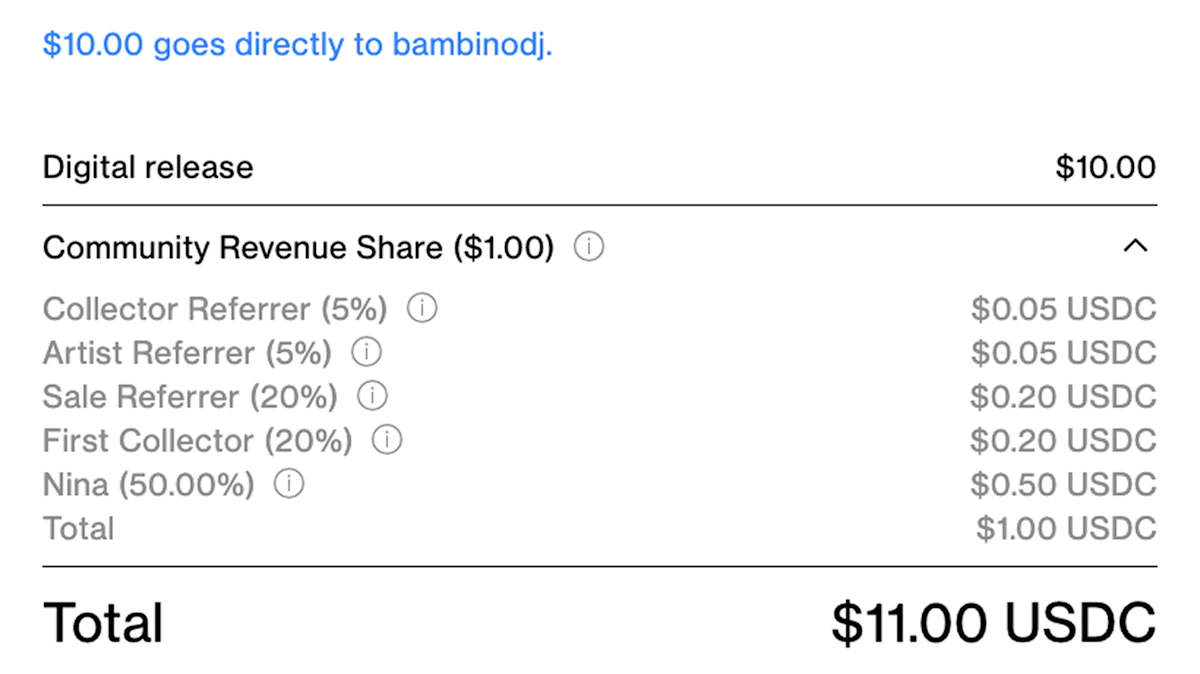Nina’s Community Revenue Share Model Is a Breath of Fresh Air
We’re absolutely gonzo for Nina’s new economic model experimentation that seeks to pay artists, as well as fans and curators, for their work in expanding discovery via the platform. Here’s how it works.

On Nina’s Reimagined Music Platform Economics That Includes Fan Payouts
Ever heard of Nina? It is a listening platform and online music store that aims to make music discovery fluid and human-powered, and bring more income back into the hands of artists with an innovative revenue sharing structure.
Over 20,000 artists, labels, and listeners around the world use Nina — both to release and to discover and new music for free — and we love it because it really does put artists’ needs in the driver’s seat of decisions made.
On that note, they’ve just launched a new version of their revenue-sharing program, which is designed to incentivize and pay fans and curators for sharing their favorite music and converting new listeners. As Nina puts it: “Nothing comes from nowhere. A writer covers a new scene. A friend sends you their latest discovery. A curator surfaces new scenes and sounds. Music spreads because people care and want to share it.”
So let’s dive in to explain how this all works, and why as an artist you might want to check this out!
What is Community Revenue Share (CRS)?
Nina’s Community Revenue Share is a new economic model built into the Nina music-platform that distributes a portion of every sale to members of the community who played a role in spreading or promoting that track.
When someone buys music on Nina, a $1 Community Revenue Share fee is added to the purchase. The artist still receives 100% of their price (i.e. the base amount for the music). The extra $1 is in addition to that price.
Then, that $1 is split among several stakeholders in the ecosystem:
- 50¢ goes to Nina’s platform operations,
- 20¢ goes to the first collector of that release,
- 20¢ goes to the person who shared the referral link leading to the sale,
- 5¢ goes to the person who invited the buyer,
- 5¢ goes to the person who invited the artist.
If one of the above “slots” is empty (ie: there is no inviter for the buyer), the money is redistributed among others, excluding Nina. The “First Collector” is a special concept: when a release is first bought, that person pays the storage cost (which Nina had covered previously) and then earns a share on future sales.

What Makes This Model So Innovative?
Traditional streaming platforms treat listeners/curators as simply consumers. Nina’s model explicitly recognizes the community as active, participatory stakeholders, acknowledging that people who share, invite, curate, or first support an artist are part of how music grows. They are not just users, they help discovery happen; which is a remunerable form of labor unto itself.
Secondly, the platform’s elevation of transparency and attribution speak to the growing demand amongst artists and listeners for the companies they patronize to be aligned ethically with one’s own values. It prioritizes openness and accountability in an era where corporations tend to keep meaningful information opaque.
Lastly, the platform’s willingness to reorient itself around micropayments, enabled by blockchain technology, shows that it is focused on the future. Whereas most “small” contributions are impractical in legacy financial systems due to transaction costs dwarfing the value, blockchain’s programmable, low-friction system makes it feasible to distribute small amounts to many participants instantly.
Why Does This Work for Musicians and Artists?
From where we’re sitting, Nina’s Community Revenue Share gives artists clear visibility into who is supporting them. Instead of relying on vague streaming data or follower counts, artists can see exactly which fans, curators, or referrers are contributing to their sales and helping spread their music.
This model also removes gatekeepers from getting in between an artist and their fans, fostering a more equitable and mutually rewarding relationship between both parties. The CRS redistribution of a portion of each sale back into the community (to collectors, sharers, and inviters) recognizes the collective labor of spreading music to new audiences. This can help build more sustainable, grassroots networks around independent creators over time.
And it lowers the financial barrier to releasing music even further than Bandcamp, for example. By shifting hosting and storage costs to the “first collector” (the first buyer of a release) artists are freed from paying those fees upfront.

Nina represents a shift from a one-way subscription payout model toward a more participatory, transparent, and community-driven economy for music. For artists, it offers new ways to reward genuinely engaged fans, curators, and supporters. For listeners, it gives real incentive and recognition for the act of sharing, and not just consuming. If you’re an independent artist or involved in music curation, exploring Nina could help you build a more engaged, financially rewarding network around your work.
For more information, read this explainer post here.